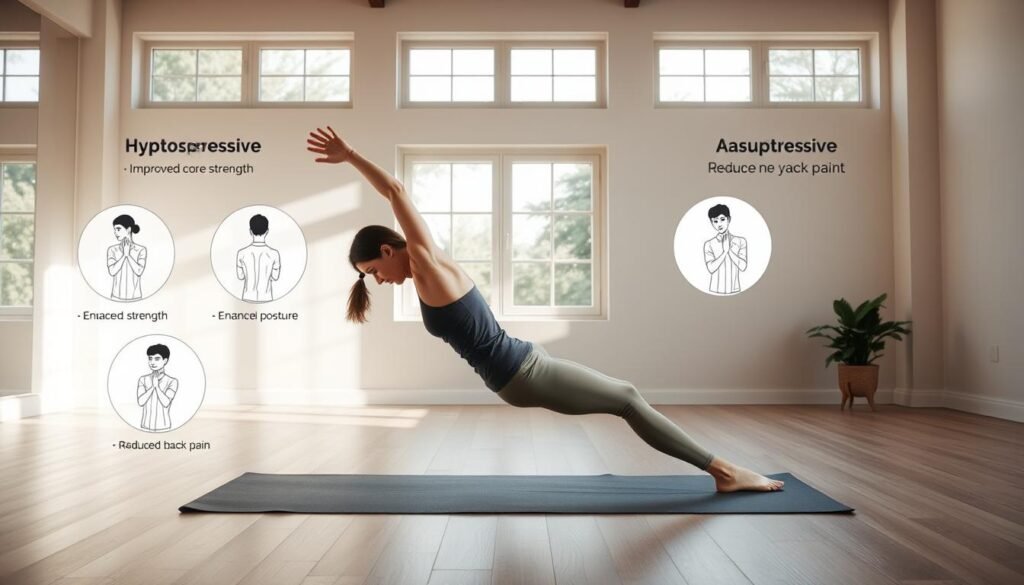
Discover the Hypopressive Workout Plan for Better Core
Did you know crunches and planks might not be the best for women after pregnancy or certain surgeries? The hypopressive workout plan is a low-impact routine that changes the game for core strength. It uses breathing and posture to strengthen your core. It was first made for postnatal women in the 1980s in Europe to help with pelvic floor issues12.
Now, it helps many people with back pain, postpartum recovery, or pelvic floor problems. These exercises make your core stronger and more stable. They’re easy to add to your daily routine.
Hypopressive exercises are special because they don’t put too much pressure on your body. They make your core, back, and pelvis stronger while improving your breathing and posture1. You can see better core function and breathing in just 20 minutes a day1.
Want to learn more about hypopressive exercises? Click here for a detailed guide. Start this low-impact routine and see how it improves your core strength and overall health.
Key Takeaways
- Hypopressive exercises offer a unique, low-impact alternative to traditional core workouts.
- Originally designed for postnatal women, these exercises are now beneficial for a wider audience.
- Focusing on breathing and posture, hypopressive workouts reduce pressure on pelvic organs.
- A regular routine can improve core function and restore respiratory patterns in just 20 minutes a day.
- Start integrating hypopressive exercises into your daily life for better core stability and overall fitness.
Introduction to Hypopressive Exercises
Hypopressive exercises are a special kind of workout that focuses on lowering pressure in the belly and pelvic areas. They help improve core strength and can lead to better posture, a stronger pelvic floor, and easier breathing. These exercises use a technique called abdominal compression to work deep core muscles.
What are Hypopressive Exercises?
These exercises aim to reduce pressure in the chest, belly, and pelvic areas. They use specific postures and breathing techniques to contract muscles involuntarily. They’re great for preventing urine leaks after surgery or childbirth, with an 80% drop in belly pressure compared to regular workouts3.
History and Origin
Hypopressive exercises come from Europe, blending yoga and bodybuilding. They were developed into Low Pressure Fitness (LPF) techniques to improve core and pelvic muscle health. They’re perfect for new moms or those recovering from belly surgeries.
These exercises are a full-body fitness approach, helping 90% of people improve their posture and waist size, great for post-natal moms4. They boost flexibility and breathing, showing big improvements in physical abilities3. They also help fix belly muscle gaps, tone deep muscles, and keep a healthy posture without harming the belly3.
To learn more about hypopressive exercises, check out the detailed studies and insights from professionals at Activcore.
Benefits of Hypopressive Training
Hypopressive training boosts physical health in many ways. It focuses on lowering intra-abdominal pressure, unlike most exercises that raise it. This method strengthens deep muscles in the abdomen and pelvic floor. It also helps reduce lower back pain and can treat urinary incontinence5. Plus, it improves lung capacity and breathing5. Its growing popularity shows it’s effective and appealing6.
Core Strengthening
Hypopressive training is great for strengthening the core. Holding postures for up to 20 minutes works the deep muscles6. This makes the core more stable and powerful, helping with daily tasks and sports. It also cuts down on lower back pain by aligning the spine5
Pelvic Floor Fortification
Hypopressive training puts a lot of focus on strengthening the pelvic floor. Studies show it greatly improves muscle strength and tone, boosting life quality7. It’s very helpful for women with urinary incontinence and early pelvic organ prolapse. Women see better bladder control and sexual health7. It’s also good for postpartum recovery6.
Posture Improvement
Hypopressive training also improves posture. It uses breathing and postures to align the body and prevent back pain5. This helps maintain a good posture and supports all movements. It’s good for both those who sit a lot and athletes, as it makes movements more efficient and safer6.
Here’s a detailed comparison of traditional core exercises versus hypopressive training in a table format:
| Aspect | Traditional Core Exercises | Hypopressive Training |
|---|---|---|
| Pressure Dynamics | Increase intra-abdominal pressure | Reduce intra-abdominal pressure5 |
| Core Engagement | Superficial muscles | Deep abdominal muscles5 |
| Pelvic Floor Strength | Not directly targeted | Directly strengthens pelvic floor muscles7 |
| Lung Capacity | Not focused on | Improves breathing efficiency5 |
| Posture | General core stability | Corrects body alignment5 |
Who Can Benefit from Hypopressives?
Hypopressive exercises help many people, like those recovering from childbirth, dealing with back pain, and facing pelvic floor issues.
Postpartum Women
After childbirth, women often want to regain their abdominal strength and pelvic health. Hypopressives were introduced in Spain around 2012. They use low-pressure poses, breathing techniques, stretching, and neurodynamics to strengthen deep muscles without raising belly pressure8.
In countries like France, Spain, and Brazil, hypopressives are a key part of postpartum care9. Many women see big improvements in their deep abdominal and pelvic floor muscles10.

People with Back Pain
Those with chronic back pain find hypopressives very helpful. These exercises manage belly pressure and stabilize the pelvis10. Athletes use them to protect their backs from high-impact sports9.
They also help improve posture, which is key in reducing back pain9.
Individuals with Pelvic Floor Disorders
People with pelvic floor issues like incontinence, prolapse, and sexual problems find hypopressives very beneficial. These exercises don’t raise belly pressure, making them perfect for pelvic floor problems8.
A 2020 study showed hypopressives help women with pelvic floor dysfunction9. They can also boost posture, energy, and overall life quality9.
Hypopressive Workout Plan
The hypopressive workout plan starts with simple exercises. It focuses on breathing and moves to more complex ones. It’s designed for safety and effectiveness, fitting all fitness levels and health conditions.
Beginners should do the workout three times a week for 15-20 minutes11. As you get better, you can do it five times a week for 15-35 minutes11. If you love it, you can do it daily with longer sessions of 20-35 minutes, three times a week, and shorter ones on other days11. Remember to rest your core muscles for at least two days a week11.
Adding hypopressive training to your routine can be great11. Do it as a warm-up or cool-down. For best results, do longer sessions in the morning on an empty stomach. This helps with meditation and aligning your core, which is important during apnea11.
A study with 117 participants showed great results. The hypopressive group saw big improvements in pelvic floor muscle strength. They also scored better on the Pelvic Floor Impact Questionnaire (PFIQ-7) and the Pelvic Floor Distress Inventory (PFDI-20)12.
The study was about an 8-week hypopressive exercise program. It was for women with pelvic floor dysfunction and urinary incontinence. They did the workout twice a week for 20 minutes. After eight weeks, they had less urinary incontinence symptoms12.
| Group | Participants | Pelvic Floor Muscle Strength | PFIQ-7 Score | PFDI-20 Score |
|---|---|---|---|---|
| Hypopressive Group | 62 | F(1117) = 89.514, p < 0.001 | t(112) = 28.895, p < 0.001 | t(112) = 7.037, p < 0.001 |
| Control Group | 55 | Not Applicable | Not Applicable | Not Applicable |
In conclusion, a hypopressive workout plan is great for strengthening your core and pelvic floor. It’s a low-impact way to improve your fitness and well-being.
How Hypopressives Differ from Traditional Exercises
The hypopressive method has unique benefits compared to traditional exercises. Crunches and sit-ups can increase pressure inside the belly, leading to problems like incontinence and hernias13. Hypopressives, on the other hand, lower this pressure and work the abdominal muscles safely and effectively14.

Hypopressive vs. Hyperpressive
Hypopressives and hyperpressives differ in how they engage the core muscles. Hypopressives cause all core muscles to contract involuntarily, which helps lower belly pressure15. This is key for better posture and a slimmer waistline15. Hyperpressives, or traditional exercises, can increase belly pressure, leading to issues like diastasis recti and organ prolapse14.
Subconscious Muscle Activation
The hypopressive method focuses on subconscious muscle activation. It works the core muscles, including the diaphragm and pelvic floor, together for better function15. This improves lung function, posture, and pelvic floor tone15. You can do hypopressives in different positions, like sitting with hands on knees to lift the rib cage15.
Exploring hypopressives can lead to many benefits. These include a better quality of life, improved posture, and prevention of pelvic problems. All these contribute to overall health and pain prevention hypopressive method benefits13.
Step-by-Step Guide to Hypopressive Exercises
Starting with a strong foundation in hypopressive exercises is key to success. This guide will walk you through different positions, each one more challenging and beneficial. Follow these steps to learn the correct techniques.
Lying Down Exercises
Lying down exercises are the foundation of this guide. Start by lying on your back with knees bent and feet flat. Use deep breathing to engage your core muscles16.
Focus on auto-elongation and creating a double chin as you breathe deeply. Practice apnea and tuck your abdomen16.
Sitting Exercises
Sitting exercises are a bit more challenging. Sit on a mat with legs crossed and back straight. Use deep breathing to engage slow twitch muscle fibers and prevent fatigue16.
Follow the same breathing techniques as lying down to ensure optimal core engagement.
Leaning Forward Exercises
Leaning forward exercises add complexity. Start by bending at the hips and placing your hands on a sturdy surface like a table. This position emphasizes core control and breathing.
Continue to use deep breathing and focus on maintaining auto-elongation and apnea17.
Kneeling Exercises
Kneeling exercises require balance and core engagement. Begin in a kneeling stance on the mat. Keep your back straight and core activated.
These exercises are great for improving whole-body circulation and can be done in 5-30 minutes17. Proper execution means keeping your core muscles engaged throughout.
Common Mistakes to Avoid
It’s important to use the right techniques and not push too hard when doing hypopressive training. Here are some common mistakes to watch out for and avoid during your workouts.
Incorrect Breathing Techniques
Mastering the right breathing is key in hypopressive exercises. The abdominal vacuum helps with pelvic floor issues like prolapse and incontinence18. If you breathe wrong, you might not get the full benefit and could even hurt yourself.
To avoid mistakes, make sure you’re using the right muscles and breathing calmly. Focus on exhaling fully and keeping your spine straight for the best results18.
Overexertion
Start slow with hypopressive training to avoid too much stress on your body. Many beginners push too hard, leading to fatigue and injury. It’s key to progress slowly and listen to your body.
Doing high-intensity workouts like HIIT too soon after pregnancy can cause problems like incontinence and back pain19. Instead, try Low Pressure Fitness to help manage stress and improve sleep, which is great for those with stressful jobs18.
| Exercises | Benefits |
|---|---|
| Hypopressives | Restore pelvic floor, improve posture, tighten deep abdominals, enhance respiratory parameters, and improve sexual intercourse19. |
| Low Pressure Fitness | Reduce stress, improve sleep, manage prolapse, stress incontinence, and diastasis recti18. |
By following these tips and avoiding common mistakes, you’ll have a safe and effective workout.
When to Expect Results
Knowing when you’ll see results from hypopressive exercises can keep you motivated. You’ll start to notice improvements in core strength and pelvic floor health quickly with regular practice.
Timeline for Visible Changes
Research shows that noticeable changes in core strength happen in two to three months. A study with thirty-six healthy females found better pelvic floor muscle strength after eight weeks of hypopressive training, done three times a week20.
Working with certified physiotherapists can lead to visible results in six weeks21. You might see improvements in posture and muscle tension in just two weeks22.
Maintenance Phase
To keep up the good work, a regular hypopressive routine is important. After reaching your goals, keep practicing these exercises. Regular use of hypopressives can lead to ongoing improvements in incontinence, posture, and muscle health22.
Staying consistent and following a fitness routine that includes hypopressives is key. This helps maintain the benefits on core strength and pelvic floor stability21. Dedication, with guidance from trained physiotherapists, is necessary to avoid losing the progress made22.
Conclusion
The hypopressive workout plan is a great way to boost core strength and pelvic health. It uses special breathing and low-impact exercises. This makes it effective without the high strain of intense workouts.
Studies show it can really improve core and pelvic floor strength with regular practice23. This is a big plus for those looking to get stronger.
It’s also great for easing pelvic floor issues, which affect up to 25% of women. This number goes up with age23. Adding hypopressive training to your routine can offer a lot of relief.
It’s also safer than high-impact activities. This makes it a good choice for keeping fit without too much stress24.
For a full fitness experience, try the “Fitter Floor and Core” online course. It combines hypopressives with Pilates and functional fitness. You can join live classes and access lots of resources anytime, making it easy to stick to your routine24.
As more people try hypopressive workouts, they’ll see how it can improve their life. It’s a path to better health and a higher quality of life.
FAQ
What are Hypopressive Exercises?
What is the history and origin of Hypopressive Exercises?
What are the core strengthening benefits of Hypopressive Training?
How do Hypopressive Exercises fortify the pelvic floor?
In what ways do Hypopressives improve posture?
How can postpartum women benefit from Hypopressive Exercises?
Are Hypopressives suitable for people suffering from back pain?
What is included in a Hypopressive Workout Plan?
How do Hypopressives differ from traditional exercises?
What are the steps for performing Hypopressive Exercises?
What common mistakes should be avoided when practicing Hypopressive Exercises?
When can one expect to see results from Hypopressive Exercises?
Source Links
- Hypopressive Training Simplified • Hypopressives Canada
- Discover Hypopressive Exercise: A Safer Path to Core Strength – Complete Core Control and Fit Mummy
- Hypopressive Abdominals: Benefits and Exercises – HSN Blog
- Videos – Coreset Fitness
- Hypopressive exercises: benefits, patient routine and examples • TRAK
- Benefits of Low Pressure Fitness, the Hypopressive Technique | Burnaby Physiotherapy Clinic, Physio in Burnaby, Sports Rehab
- Effectiveness of Hypopressive Exercises in Women with Pelvic Floor Dysfunction: A Randomised Controlled Trial
- Low Pressure Fitness | Hypopressive Exercise | Core Functional Wellness
- Hypopressives or Low Pressure Fitness
- Hypopressives | Hypopressive Exercises Cambridge
- How to Start a Hypopressive Training Practice
- The effects of an 8‐week hypopressive exercise training program on urinary incontinence and pelvic floor muscle activation: A randomized controlled trial
- Traditional Abdominal Workout Vs Hypopressive Abdominal Workout – Core Fit Yoga
- What is Hypopressive and How Do You Practice Hypopressives? – Core Fit Yoga
- Safely building your core: Hypopressives vs. traditional abdominal exercises – Sedona Physical Therapy
- How to Do Hypopressive Exercises – 7 steps
- Hypopressive Exercise
- Hypopressives: A Holistic Approach to Pelvic Health, Postpartum Recovery, and so much more!
- A Pressure-Less Workout To Restore the Mommy Core and Pelvic Floor
- ICS 2024 Abstract #21 Do eight weeks of experience with hypopressive exercise training impact pelvic floor muscle strength, stiffness or task performance? An interventional cohort.
- Hypopressive Exercises For The Pelvic Floor: Why Is There Are Growing | PhysioCentral
- Client Stories • Hypopressives Canada Pelvic Floor Health | Core Training
- Effects of Hypopressive Abdominal Training on Ventilatory Capacity and Quality of Life: A Randomized Controlled Trial
- Hypopressive Exercises Versus Yoga: A Detailed Comparison – Complete Core Control and Fit Mummy






